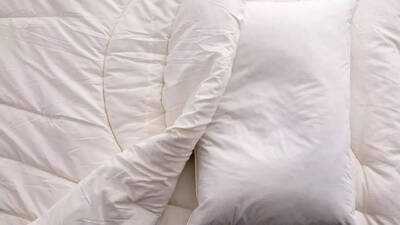We carefully scan expiration dates on milk cartons, medicines, or face creams, but hardly anyone stops to think about whether their pillow might also come with a shelf life. It is one of the most intimate objects we use, spending a third of our lives in direct contact with our skin and airways. Over time, pillows inevitably lose their structure, trap oils and sweat, and harbor allergens.
Orthopaedic surgeon and health educator Dr. Manan Vora recently reignited this discussion on Instagram, warning that an old pillow isn’t just a comfort issue- it could be affecting your sleep quality, skin, and even your respiratory health.
Why pillows have an “expiration date”
Dr. Vora argues that pillows deserve the same scrutiny as other consumables, since they collect dead skin cells, saliva, body oils, and dust mites night after night. In fact, researchers have long confirmed that bedding can serve as a major reservoir for house dust mites, one of the most common indoor allergens. Studies have noted that pillows, mattresses, and duvets are the largest reservoirs of mite allergens in the home, directly contributing to symptoms in people with asthma or allergic rhinitis.

Beyond allergens, there are also concerns about the breakdown of pillow materials. Many modern pillows are made from polyurethane or memory foam, which can degrade over time. Emissions from polyurethane foam and found that volatile organic compounds (VOCs) can be released as the material ages, potentially affecting indoor air quality. While this doesn’t mean every pillow poses a serious risk, it highlights why prolonged use without replacement may not be ideal.
The health effects range from mild irritation to more serious consequences. A dirty pillow can worsen acne or trigger flare-ups in sensitive skin. Dermatologists often point to the accumulation of oils and bacteria in bedding as a contributing factor for breakouts. On the respiratory side, long-term exposure to dust mite allergens has been directly linked to worsened asthma outcomes.
How long a pillow really lasts

Pillow longevity varies widely depending on the material, and knowing when to replace yours can make a big difference to sleep quality and hygiene. Polyester pillows, commonly used for their affordability and lightness, generally last between six months and two years. Feather pillows tend to hold up slightly longer, maintaining comfort and support for about one to three years with proper care. Memory foam pillows, prized for contouring support, usually remain effective for two to three years before losing their shape or resilience.
Latex pillows are slightly more durable, often lasting three to four years thanks to their natural elasticity and resistance to flattening. Buckwheat pillows stand out as the most long-lasting option, with a typical lifespan of three to five years, especially when the hulls are periodically fluffed or refilled.
Orthopaedic surgeon and health educator Dr. Manan Vora recently reignited this discussion on Instagram, warning that an old pillow isn’t just a comfort issue- it could be affecting your sleep quality, skin, and even your respiratory health.
Why pillows have an “expiration date”
https://www.instagram.com/reel/DPY5kZojMY3/?utm_source=ig_embed&ig_rid=6fa74a2c-94a1-4d25-a506-612e8037f5b3 https://www.instagram.com/reel/DPY5kZojMY3/?utm_source=ig_embed&ig_rid=6fa74a2c-94a1-4d25-a506-612e8037f5b3
Dr. Vora argues that pillows deserve the same scrutiny as other consumables, since they collect dead skin cells, saliva, body oils, and dust mites night after night. In fact, researchers have long confirmed that bedding can serve as a major reservoir for house dust mites, one of the most common indoor allergens. Studies have noted that pillows, mattresses, and duvets are the largest reservoirs of mite allergens in the home, directly contributing to symptoms in people with asthma or allergic rhinitis.
Beyond allergens, there are also concerns about the breakdown of pillow materials. Many modern pillows are made from polyurethane or memory foam, which can degrade over time. Emissions from polyurethane foam and found that volatile organic compounds (VOCs) can be released as the material ages, potentially affecting indoor air quality. While this doesn’t mean every pillow poses a serious risk, it highlights why prolonged use without replacement may not be ideal.
The health effects range from mild irritation to more serious consequences. A dirty pillow can worsen acne or trigger flare-ups in sensitive skin. Dermatologists often point to the accumulation of oils and bacteria in bedding as a contributing factor for breakouts. On the respiratory side, long-term exposure to dust mite allergens has been directly linked to worsened asthma outcomes.
How long a pillow really lasts
Pillow longevity varies widely depending on the material, and knowing when to replace yours can make a big difference to sleep quality and hygiene. Polyester pillows, commonly used for their affordability and lightness, generally last between six months and two years. Feather pillows tend to hold up slightly longer, maintaining comfort and support for about one to three years with proper care. Memory foam pillows, prized for contouring support, usually remain effective for two to three years before losing their shape or resilience.
Latex pillows are slightly more durable, often lasting three to four years thanks to their natural elasticity and resistance to flattening. Buckwheat pillows stand out as the most long-lasting option, with a typical lifespan of three to five years, especially when the hulls are periodically fluffed or refilled.
You may also like

Jamie Carragher doubles down on Liverpool 'basketball team' criticism after Chelsea defeat

Millions of Apple and Samsung users in UK could get share of £480m compensation

UP CM Yogi Adityanath Reviews Revenue Performance Of State Tax Dept, Interacts With Zonal Officers Through Video Conferencing

Lanka Premier League 2025 Returns for a December Showdown, to Serve as Build-Up Ahead of Mega Cricket Season

If you have a lot of mutilated notes at home, you can exchange them here. Learn the complete process.






